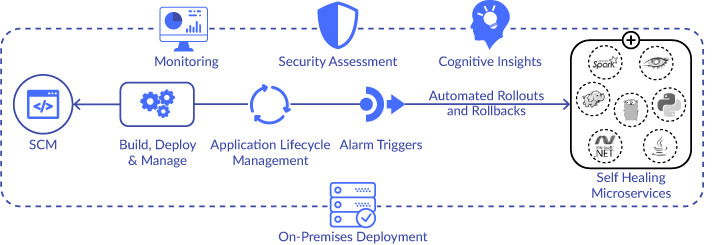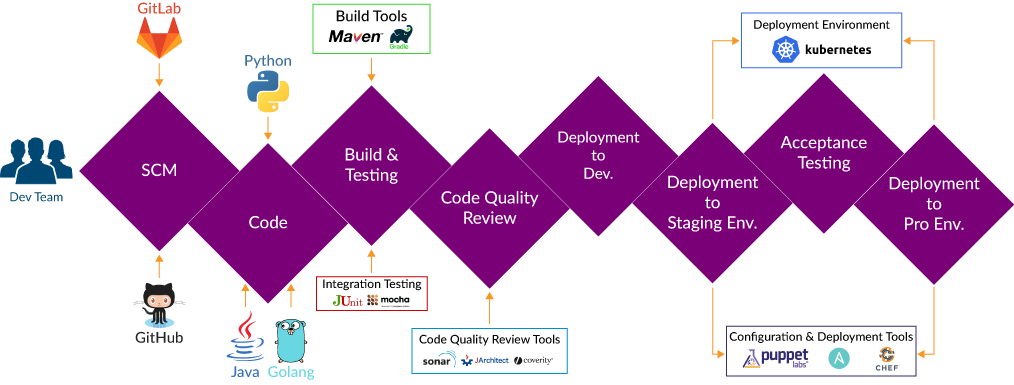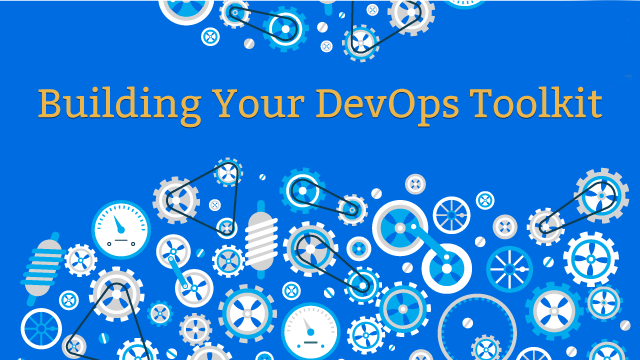DevOps ToolChain, Open Source Tools and Toolkit
Reading Time: 8 Minutes
DevOps Overview
DevOps isn't a tool or a product. DevOps is a process and balanced organization approach for improving collaboration, communication among development and operation.
Redesigning and find new ways for faster and Reliable Delivery for accelerated time to market, improved manageability, better operational efficiency, and more time to focus on your core business goals.

Building Open-Source DevOps Toolchain
During Transformation Towards Agile & DevOps, DevOps needs a platform where we can define workflow with different Integrations. Implementing DevOps Culture into your workflow requires using of specialized tools.
Below is an outline of each key category of tools that need to be in your DevOps Toolkit, and the leading technologies to consider as you build the DevOps toolkit that best supports your team and your organization.
Source Code Management Tools
Everything we build can be expressed through code. But when everything is the code you need to be sure that you can control and perform branching on it – otherwise things could get chaotic. So to avoid that chaos we use SCM Tools that includes -
-
GitHub
GitHub is a web-based Git or Version Control Repository
-
Gitlab
Gitlab provided Git Repository Management, Code Review, Issue Tracking, Activity Feeds and Wikis.
Continuous Integration Tools
Continuous Integration is a fundamental best practice of modern Software Development. By Setting up an effective Continuous Integration environment, we can
-
Reduce Integration Issues
-
Improve Code Quality
-
Improve Communication and Collaboration between Team Members
-
Faster Releases
-
Fewer Bugs

-
Continuous Integration using Jenkins
Jenkins is used as Continuous Integration Platform to merge code from individual developers into a single project, multiple times per day and test continuously to avoid any downstream problems.
Overview of Jenkins Features
-
Integration with SCM Tools
-
Secret Management
-
SSH-Based Access Management
-
Scheduling and Chaining of Build Jobs
-
Source Code Change Based Triggers
-
Worker/Slave Nodes
-
Rest API Support
-
Notification Management
You May also Love to Read DevOps Implementation approach and Best Practices to Adopt DevOps in your Enterprise
Build Tools in DevOps
While building our organization, we have invested much of our time in research as which DevOps Tools we need to include in our DevOps toolkit and which not to. These decisions are based on our years of experience in IT industry. We've taken great care in selecting, benchmarking and continually improving our tools selection.
By sharing our Tools, we hope to foster a discussion within the DevOps community so that we can further improve.
-
Apache Maven For DevOps
Apache Maven is a Software Project Management and Comprehension Tool. Based on the concept of a Project Object Model (POM), Apache Maven can manage a project's build, reporting, and documentation from a central piece of information.
-
Apache Ant
Apache Ant is a Java library and command-line tool whose mission is to drive processes described in build files as targets and extension points dependent upon each other.
-
Gradle Build Tool
Gradle is a build tool with a focus on build automation and support for multi-language development.
-
Grunt - Javascript Task Runner
Grunt is a JavaScript task runner, a tool used to automatically perform frequently used functions such as Minification, Compilation, Unit Testing, Linting, etc.
-
GNU Make
Make is a build automation tool that automatically builds executable.
-
Packer - Build Automated Machine Images
Packer is a free and open source tool for creating golden images for multiple platforms from a single source configuration.
Tools For Continuous Testing
To achieve the desired business goals of DevOps, you need to have an accurate, real-time measure of the risks and quality assurance of the features in your Delivery Pipeline and this can only be achieved through extensive and precise testing.
Following are the testing tools being used by us to automate and streamline our DevOps Processes
-
Unit Testing With JUnit
JUnit is a simple framework to write repeatable tests.
-
Mocha - JavaScript Test Framework
Mocha is a simple, flexible, fun JavaScript test framework for Node.js.
Artifacts Repository Management Tools
Now that your build pipeline consistently versions your Maven project, you need a place to store your objects which are being produced at the end of this pipeline. These artifacts need to be stored much the same way your source code is stored in your Source Code Management System.
This ensures access to previously released versions of your product. An Artifact Repository is designed to store your war/jar/ear/etc., and distribute it to fellow developers via Maven, Ivy, or the like, share your artifact with you deployment tools, and ensure an immutable history of your released products.
-
Using a Standard Artifacts Management System such as Artifactory
-
Caching Third-Party Tools
Configuration Management Tools
Configuration management is the process of standardizing resource configurations and enforcing their state across IT infrastructure in an automated yet agile manner.
-
Ansible - Simple IT Automation
Ansible is an agentless configuration management system which relies on SSH protocol.
-
Chef & Puppet
Chef and Puppet are agent-based configuration management system.
Continuous Deployment Tools
Continuous Deployment is a software development practice in which every code change goes through the entire pipeline and is put into production, automatically, resulting in many production deployments every day.
-
Supervisor - Process Control System
The Supervisor is a client/server system that allows its users to monitor and control some processes on UNIX-like operating systems.
-
PM2 - Production Process Manager For Node.JS
PM2 is an advanced, production process manager for Node.js.
-
Forever - CLI Tool
Forever is simple CLI tool for ensuring that a given script runs continuously.
DevOps Orchestration Tools
Software systems that facilitate the automated management, scaling, discovery, and deployment of container-based applications or workloads.
-
Kubernetes - Container Orchestration
Kubernetes is an orchestration system for Docker containers. It handles scheduling and manages workloads based on user-defined parameters.
-
Orchestration with Docker Swarm
Docker Swarm provides native clustering functionality for Docker containers, which lets you turn a group of Docker engines into a single, virtual Docker engine.
You May also Love to Read Docker Overview - A Complete Guide
Continuous Monitoring DevOps Tools
The end goal of your monitoring is to consolidate tools, reduce the total cost of ownership, and automate the configuration via Machine Learning.
-
Zabbix - Open-Source Network Monitoring Tool
Monitoring is defined on different levels like a system, platform, application, etc. Data-driven based monitoring is done with the help of Zabbix.
-
ELK Stack
ELK (Elasticsearch, Logstash & Kibana) Stack provides actionable insights in Real-Time from almost any type of structured and unstructured data source.
-
Grafana - Platform For Analytics & Monitoring
Grafana is most commonly used for visualizing time series data from infrastructure and application analytics, but many use it in other domains including industrial sensors, home automation, weather, and process control.
Tools For Effective DevOps Collaboration
-
Rocket Chat
Rocket Chat is an open-source messaging app built with Meteor. It supports video conferencing, file sharing, voice messages, has a fully-featured API, and more. Rocket Chat is ideal for those who prefer to have full control over their communications.
-
Slack
Slack is a messaging app on steroids. It's meant for teams and workplaces can be used across multiple devices and platforms, and is equipped with robust features that allow you to not only chat one-on-one with associates but also in groups. You're able to upload and share files with them too, as well as integrate with other apps and services, such as Skype for video calls, and you can granularly control almost every setting, including the ability to create custom emoji.
Incident Management For DevOps
Bugs - Whether they be in the code or the usability of the program, can be debilitating to any project, potentially causing the entire initiative to fail. For this reason, we use Bug Management System which enables us to identify those bugs and assure the quality of our code. For Bug Management System we use,
-
Use of systems such as GitLab and Taiga.
-
Workflow related to Bug Filing and Resolution Process
-
Integrating SCM System with Bug Resolution Process using Triggers or REST APIs.
Continuous DevOps Documentation
The Documentation includes-
-
Wiki Basics
-
Using Media Wiki, Confluence, etc.
-
Documenting the DevOps Projects.
-
Organizing Documents on a Wiki-Based System for the past DevOps Projects.
Securing DevOps
Access Management
-
Users and groups
-
Access control lists
-
OpenSSH server
-
Lightweight Directory Access Protocol (LDAP)
-
Active Directory (AD)
DevOps Troubleshooting
-
nc - Simple TCP proxies, shell-script based HTTP clients and servers, network daemon testing
-
netstat- Displaying the Routing Table
-
traceroute- Provides information about the number of routes present between source to destination
-
vmstat- Summary information on Memory, Processes, Paging, etc.
-
iostat – Gives Central Processing Unit (CPU) statistics and input/output statistics for devices and partitions
-
lsof- List open files(Linux/Unix considers everything as files)
-
top- Provides a dynamic real-time view of a running system
-
nslookup- Query Internet domain name servers for information
-
ping – Packet Internet Groper
-
tcpdump- Dumps traffic on a network
-
dig – Domain Information Groper, for DNS lookup and to query DNS name servers
-
sar - Collect, report, or save system activity information
-
uptime - To get a snapshot of info about the servers time since the last reboot, and load
-
ifconfig - Configures or displays network interface parameters for a network by using TCP/IP
-
route – To show/manipulate the IP routing table
How Can Don Help You?
Our DevOps Consulting Services provides DevOps Assessment and Audit of your existing Infrastructure, Development Environment and Integration.
Our DevOps Professional Services includes -
Continuous Integration & Continuous Deployment
Don is a leading DevOps Solution Provider which provides end to end Infrastructure automation, Continuous Integration, Continuous Deployment with automated Testing and Build Process. DevOps Solutions enables Continuous Delivery Pipeline on Microservices and Serverless Computing on Docker, Kubernetes, Hybrid and Public Cloud.
Continuous Monitoring
Our DevOps Solutions enables the visibility of Continuous Delivery Pipeline with monitoring and alerting for infrastructure, processes, applications, and Hosts. Our Product, NexaTrace is a Next-generation Monitoring Product with Predictive Intelligence using Artificial Intelligence & Machine Learning for Log Analytics.
Microservices & Serverless Computing
DevOps Services provides full stack services for Microservices and Serverless computing On Docker and Kubernetes with CoreOS. Our services support DevOps Solutions For Java, DevOps Solution For Golang, DevOps Solution For Python, DevOps Solution for Ruby-On-Rails, DevOps Solution for Scala, DevOps Solution for Node.js.
NexaStack - Unified DevOps Application Delivery Platform
NexaStack is a DevOps Platform to Automate - Monitor - Analyse your Application Delivery. NexaStack DevOps Platform Accelerates your Data Driven Application Delivery with proper visibility and security. NexaStack empowers developers to provision infrastructure on their own and builds environment to start development rapidly. It helps in breaking the wall of confusion between Developers and Sysadmins.

